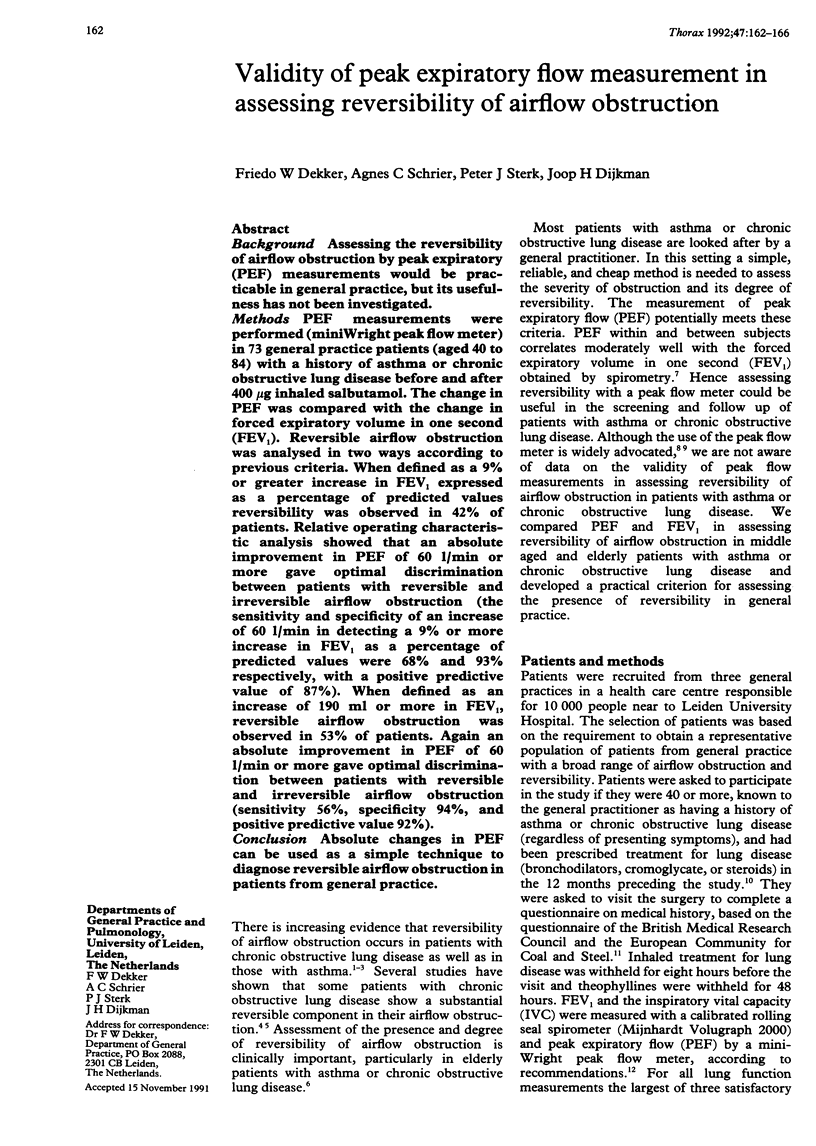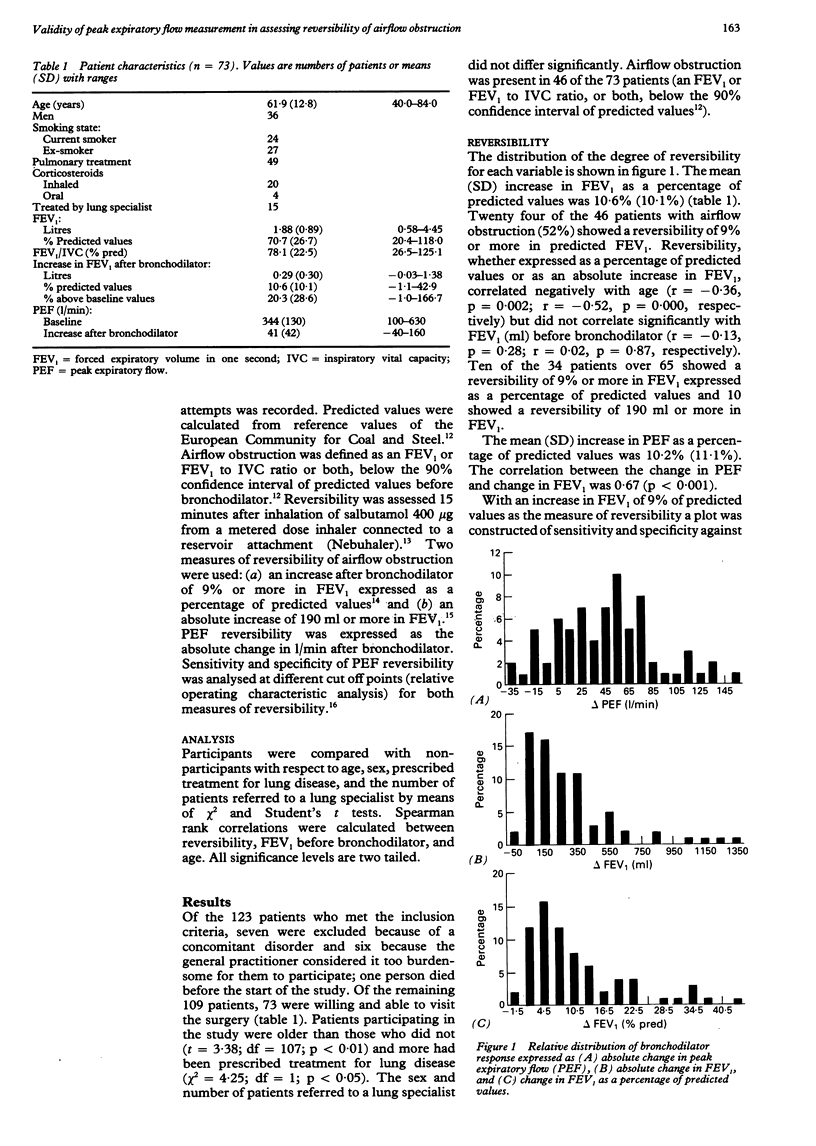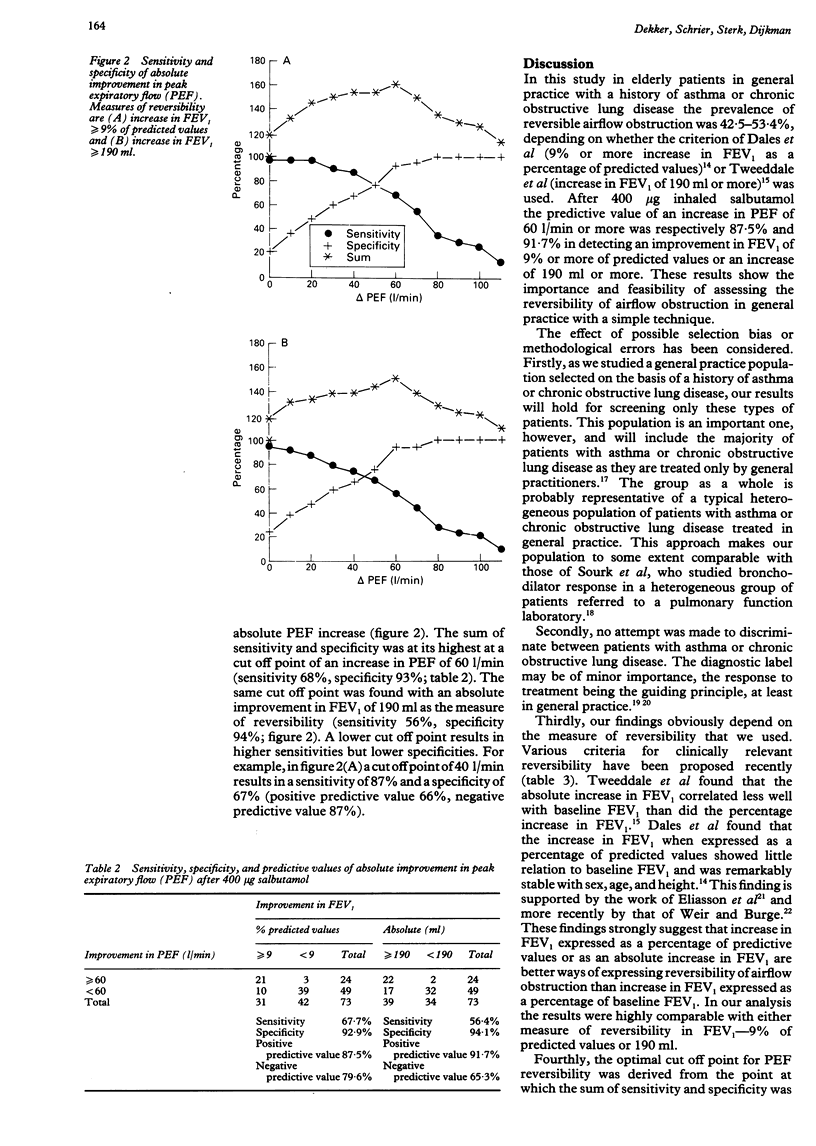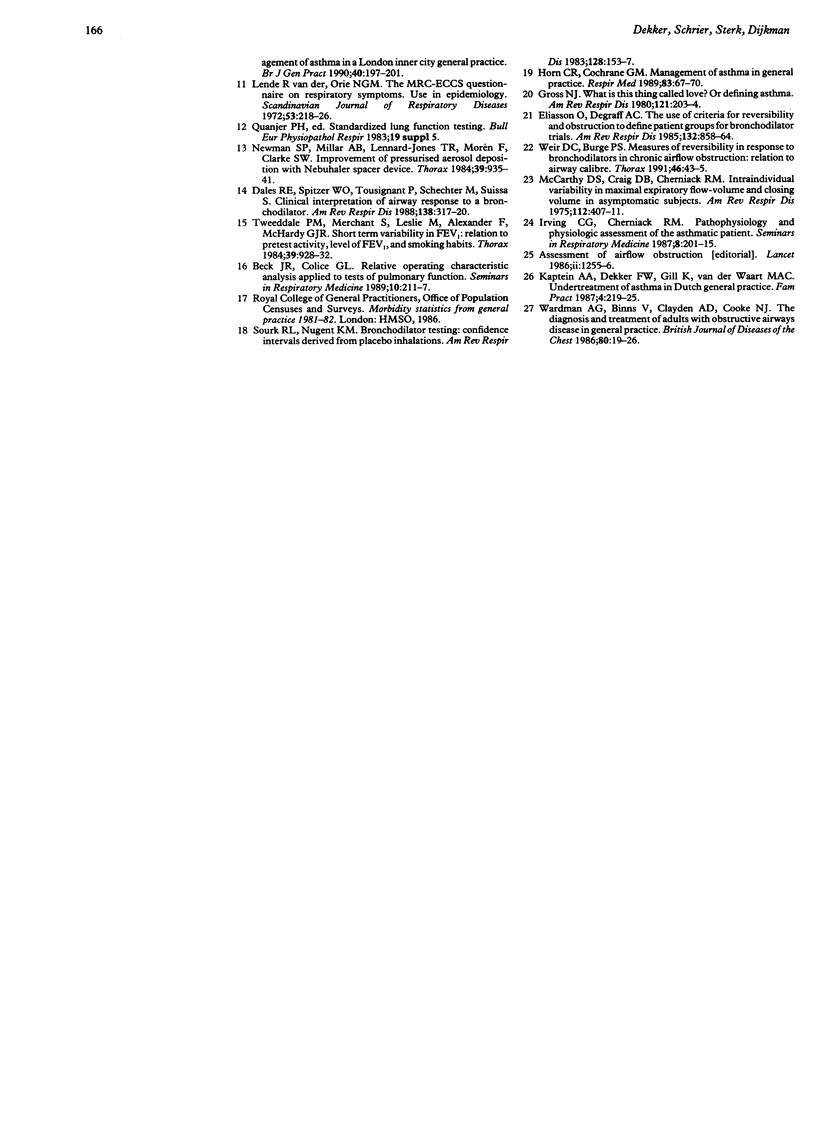Abstract
BACKGROUND: Assessing the reversibility of airflow obstruction by peak expiratory (PEF) measurements would be practicable in general practice, but its usefulness has not been investigated. METHODS: PEF measurements were performed (miniWright peak flow meter) in 73 general practice patients (aged 40 to 84) with a history of asthma or chronic obstructive lung disease before and after 400 micrograms inhaled sulbutamol. The change in PEF was compared with the change in forced expiratory volume in one second (FEV1). Reversible airflow obstruction was analysed in two ways according to previous criteria. When defined as a 9% or greater increase in FEV1 expressed as a percentage of predicted values reversibility was observed in 42% of patients. Relative operating characteristic analysis showed that an absolute improvement in PEF of 60 l/min or more gave optimal discrimination between patients with reversible and irreversible airflow obstruction (the sensitivity and specificity of an increase of 60 l/min in detecting a 9% or more increase in FEV1 as a percentage of predicted values were 68% and 93% respectively, with a positive predictive value of 87%). When defined as an increase of 190 ml or more in FEV1, reversible airflow obstruction was observed in 53% of patients. Again an absolute improvement in PEF of 60 l/min or more gave optimal discrimination between patients with reversible and irreversible airflow obstruction (sensitivity 56%, specificity 94%, and positive predictive value 92%). CONCLUSION: Absolute changes in PEF can be used as a simple technique to diagnose reversible airflow obstruction in patients from general practice.
Full text
PDF




Selected References
These references are in PubMed. This may not be the complete list of references from this article.
- Anthonisen N. R., Wright E. C. Bronchodilator response in chronic obstructive pulmonary disease. Am Rev Respir Dis. 1986 May;133(5):814–819. [PubMed] [Google Scholar]
- Banerjee D. K., Lee G. S., Malik S. K., Daly S. Underdiagnosis of asthma in the elderly. Br J Dis Chest. 1987 Jan;81(1):23–29. doi: 10.1016/0007-0971(87)90104-5. [DOI] [PubMed] [Google Scholar]
- Dales R. E., Spitzer W. O., Tousignant P., Schechter M., Suissa S. Clinical interpretation of airway response to a bronchodilator. Epidemiologic considerations. Am Rev Respir Dis. 1988 Aug;138(2):317–320. doi: 10.1164/ajrccm/138.2.317. [DOI] [PubMed] [Google Scholar]
- Drazen J. M., Gerard C. Reversing the irreversible. N Engl J Med. 1989 Jun 8;320(23):1555–1556. doi: 10.1056/NEJM198906083202311. [DOI] [PubMed] [Google Scholar]
- Eliasson O., Degraff A. C., Jr The use of criteria for reversibility and obstruction to define patient groups for bronchodilator trials. Influence of clinical diagnosis, spirometric, and anthropometric variables. Am Rev Respir Dis. 1985 Oct;132(4):858–864. doi: 10.1164/arrd.1985.132.4.858. [DOI] [PubMed] [Google Scholar]
- Gellert A. R., Gellert S. L., Iliffe S. R. Prevalence and management of asthma in a London inner city general practice. Br J Gen Pract. 1990 May;40(334):197–201. [PMC free article] [PubMed] [Google Scholar]
- Gregg I. The quality of care of asthma in general practice--a challenge for the future. Fam Pract. 1985 Jun;2(2):94–100. doi: 10.1093/fampra/2.2.94. [DOI] [PubMed] [Google Scholar]
- Gross N. J. COPD: a disease of reversible air-flow obstruction. Am Rev Respir Dis. 1986 May;133(5):725–726. doi: 10.1164/arrd.1986.133.5.725. [DOI] [PubMed] [Google Scholar]
- Gross N. J. What is this thing called love? --or, defining asthma. Am Rev Respir Dis. 1980 Feb;121(2):203–204. doi: 10.1164/arrd.1980.121.2.203. [DOI] [PubMed] [Google Scholar]
- Guyatt G. H., Townsend M., Pugsley S. O., Keller J. L., Short H. D., Taylor D. W., Newhouse M. T. Bronchodilators in chronic air-flow limitation. Effects on airway function, exercise capacity, and quality of life. Am Rev Respir Dis. 1987 May;135(5):1069–1074. doi: 10.1164/arrd.1987.135.5.1069. [DOI] [PubMed] [Google Scholar]
- Horn C. R., Cochrane G. M. Management of asthma in general practice. Respir Med. 1989 Jan;83(1):67–70. doi: 10.1016/s0954-6111(89)80062-9. [DOI] [PubMed] [Google Scholar]
- Kaptein A. A., Dekker F. W., Gill K., van der Waart M. A. Undertreatment of asthma in Dutch general practice. Fam Pract. 1987 Sep;4(3):219–225. doi: 10.1093/fampra/4.3.219. [DOI] [PubMed] [Google Scholar]
- Katz D. N. The Mini-Wright Peak Flow Meter for evaluating airway obstruction in a family practice. J Fam Pract. 1983 Jul;17(1):51–57. [PubMed] [Google Scholar]
- Kelly C. A., Gibson G. J. Relation between FEV1 and peak expiratory flow in patients with chronic airflow obstruction. Thorax. 1988 Apr;43(4):335–336. doi: 10.1136/thx.43.4.335. [DOI] [PMC free article] [PubMed] [Google Scholar]
- McCarthy D. S., Craig D. B., Cherniack R. M. Intraindividual variability in maximal expiratory flow-volume and closing volume in asymptomatic subjects. Am Rev Respir Dis. 1975 Sep;112(3):407–411. doi: 10.1164/arrd.1975.112.3.407. [DOI] [PubMed] [Google Scholar]
- Newman S. P., Millar A. B., Lennard-Jones T. R., Morén F., Clarke S. W. Improvement of pressurised aerosol deposition with Nebuhaler spacer device. Thorax. 1984 Dec;39(12):935–941. doi: 10.1136/thx.39.12.935. [DOI] [PMC free article] [PubMed] [Google Scholar]
- Sourk R. L., Nugent K. M. Bronchodilator testing: confidence intervals derived from placebo inhalations. Am Rev Respir Dis. 1983 Jul;128(1):153–157. doi: 10.1164/arrd.1983.128.1.153. [DOI] [PubMed] [Google Scholar]
- Tweeddale P. M., Merchant S., Leslie M., Alexander F., McHardy G. J. Short term variability in FEV1: relation to pretest activity, level of FEV1, and smoking habits. Thorax. 1984 Dec;39(12):928–932. doi: 10.1136/thx.39.12.928. [DOI] [PMC free article] [PubMed] [Google Scholar]
- Wardman A. G., Binns V., Clayden A. D., Cooke N. J. The diagnosis and treatment of adults with obstructive airways disease in general practice. Br J Dis Chest. 1986 Jan;80(1):19–26. doi: 10.1016/0007-0971(86)90005-7. [DOI] [PubMed] [Google Scholar]
- Weir D. C., Sherwood Burge P. Measures of reversibility in response to bronchodilators in chronic airflow obstruction: relation to airway calibre. Thorax. 1991 Jan;46(1):43–45. doi: 10.1136/thx.46.1.43. [DOI] [PMC free article] [PubMed] [Google Scholar]
- van der Lende R., Orie N. G. The MRC-ECCS questionnaire on respiratory symptoms (use in epidemiology). Scand J Respir Dis. 1972;53(4):218–226. [PubMed] [Google Scholar]


